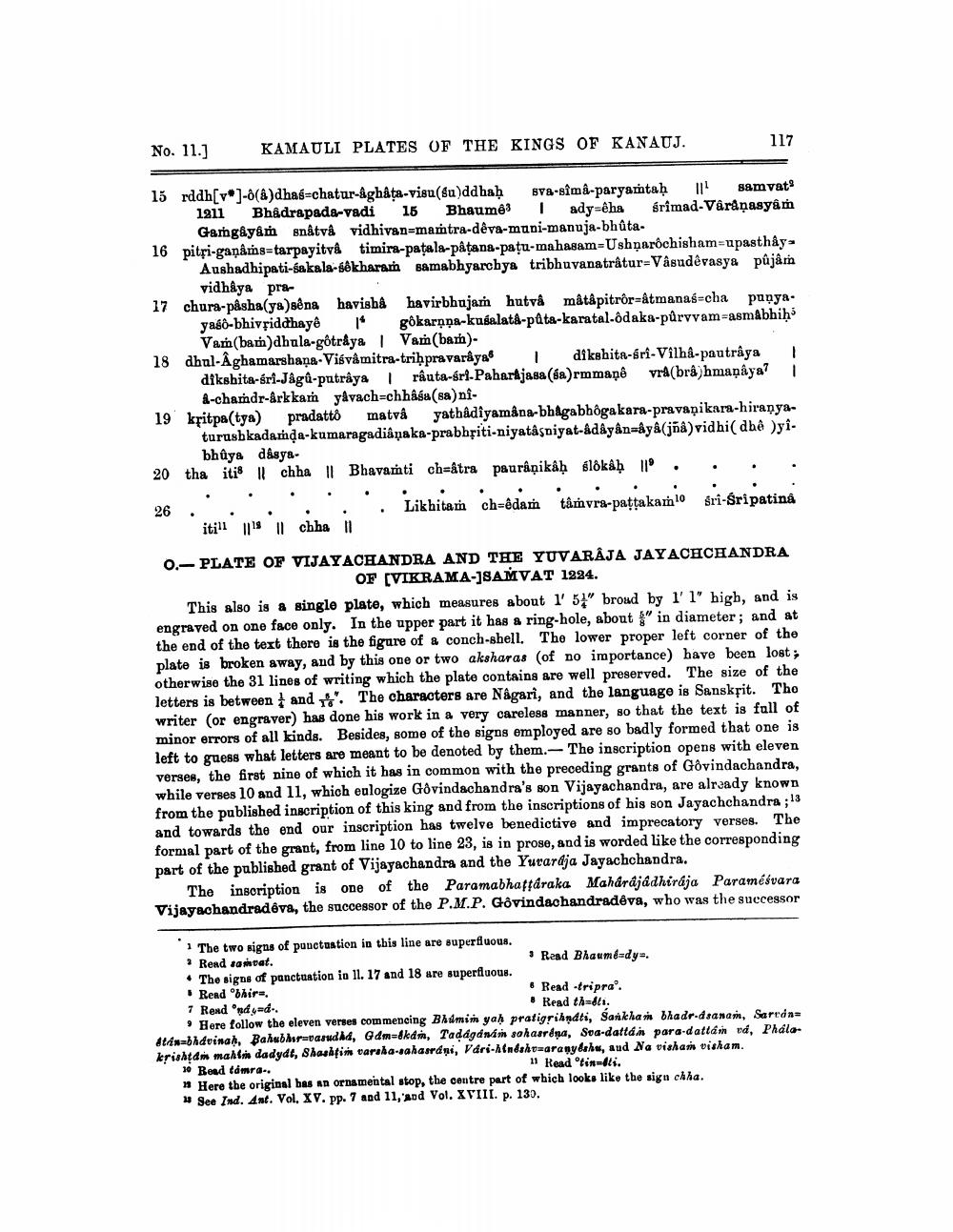________________
No. 11.)
KAMAULI PLATES OF THE KINGS OF KANAUJ.
117
15 rddh[v]-(&)dhas-chatur-&ghâta-visu (Suddhaḥ sva-simi-paryamtaḥ 11! samvat
1211 Bhadrapada-vadi 15 Bhaumes ady-êha Srimad-Vâraṇasyam
Gamgâyám endtvå vidhivan=mamtra-deva-muni-manuja-bhûta. 16 pitri-ganâng=tarpayitvå timira-patala-pâtans-patu-mahasam-Ushnarochisham=upasthây
Aushadhipati-Sakala-sê kharam samabhyarchya tribhuvanatrâtur-Vâsudêvasya půjâm
vidhya pra 17 chura-påsha(ya)sêna havishâ havirbhajar hutvà mâtâpitrôr=&tmanas-cha punya.
yasô-bhivriddhayê gôkarņņa-kusalatå-pata-karatal-ôdaka-pûrvvam=asmabhiḥ:
Vam(bam)dhula-gôtråya | Vam(bam)18 dhul-Âghamarshana-Visvamitra-trih pravaraya
dikshita-sri-Vilha-pautrâya 1 dikshita-sri-Jågû-putrâya 1 râuta-srl-Paharkjasa (fa)rmmaņa vra(brahmaņaya? !
-chamdr-arkkam yavach=chhasa (sa)ni19 kfitpa(tya) pradatto matva yathâdîyamâna-bhagabhôgakara-pravaņikara-hiraṇya
turasbkadamda-kumaragadiâņaka-prabhğiti-niyatâşniyat-adâyân=&ya(jña) vidhi( dhe Dyi
bhûya d&sya. 20 tha iti il chha || Bhavanti ch=âtra paurâņikâh slokaḥll
. . Likhitam ch=êdan tâm vra-pattakam 10 sri-śripatina
26
.
'ition
is il ciba ii
0.- PLATE OF VIJAYACHANDRA AND THE YUVARÂJA JAYACHCHANDRA
OF (VIKRAMA-]SAMVAT 1224. This also is a single plate, which measures about l' 5" broad by I' l' high, and is engraved on one face only. In the upper part it has a ring-hole, about " in diameter; and at the end of the text there is the figare of a conch-shell. The lower proper left corner of the plate is broken away, and by this one or two aksharas (of no importance) have been lost; otherwise the 31 lines of writing which the plate contains are well preserved. The size of the letters is between 1 and The characters are Nagari, and the language is Sanskrit. Tho writer (or engraver) has done his work in a very careless manner, so that the text is full of minor errors of all kinds. Besides, some of the signs employed are so badly formed that one is left to guess what letters are meant to be denoted by them. The inscription opens with eleven verses, the first nine of which it has in common with the preceding grants of Govindachandra, while verses 10 and 11, which eologize Gôvindachandra's son Vijayachandra, are already known from the published inscription of this king and from the inscriptions of his son Jayachchandra ;13 and towards the end our inscription has twelve benedictive and imprecatory verses. The formal part of the grant, from line 10 to line 23, is in prose, and is worded like the corresponding part of the published grant of Vijayachandra and the Yuvardja Jayachchandra.
The inscription is one of the Paramabhaftáraka Maharajadhiraja Paramésvara Vijayachandradêva, the successor of the P.M.P. Govindachandradêva, who was the successor
1 The two signs of panctuation in this line are superfluous. ? Read sashuat.
3 Read Bhaumdadys. • The signs of panctuation in 11. 17 and 18 are superfluous. • Rend hir,
& Read -tripra. 7 Rend ond yad..
. Read thadi. • Here follow the eleven verses commencing Blimin yah pratigrindti, Sankhar bhadr.dranan, SardaStás-bhdvinah, Bahubsr=asudad, Gdmadkdn, Tadagánki sakasrdna, Spa-dattái para-datlán rá, Phalakrishtami mahirin dadyat, Shasatin varsha-sahasrdni, Vári-A(n&sho=aranydahu, aud Na vishan visham. 10 Bead támra.
11 Read tin-di. * Here the original has an ornamental stop, the centre part of which looks like the siga chha. # See Ind. Ant. Vol. XV. pp. 7 and 11, 'Abd Vol. XVIII. p. 130.




